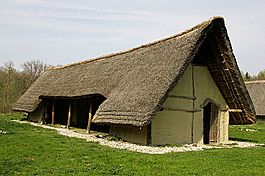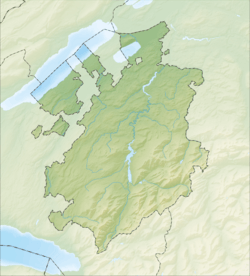Gletterens facts for kids
Quick facts for kids
Gletterens
|
||
|---|---|---|

Reconstruction of a prehistoric house in Gletterens
|
||
|
||
| Country | Switzerland | |
| Canton | Fribourg | |
| District | Broye | |
| Area | ||
| • Total | 2.58 km2 (1.00 sq mi) | |
| Elevation | 486 m (1,594 ft) | |
| Population
(Dec 2020 )
|
||
| • Total | 1,094 | |
| • Density | 424.0/km2 (1,098.2/sq mi) | |
| Postal code |
1544
|
|
| Surrounded by | Boudry (NE), Chevroux (VD), Cortaillod (NE), Delley-Portalban, Grandcour (VD), Vallon | |
Gletterens is a small town, or municipality, located in the canton of Fribourg, Switzerland. It's part of the Broye district.
One of the most interesting things about Gletterens is its ancient history. It's home to the Les Grèves prehistoric pile-dwelling settlements. These are special because they are part of the Prehistoric Pile dwellings around the Alps UNESCO World Heritage Site. This means they are recognized as very important places for everyone in the world to protect and learn from.
Contents
History of Gletterens
Gletterens is quite old! The first time it was ever written about was in the year 1239. Back then, it was called Lieterins.
Geography and Nature
Gletterens covers an area of about 2.9 square kilometers (or 1.1 square miles). Imagine a square that's about 1.7 kilometers (or 1 mile) on each side – that's roughly the size of Gletterens!
A big part of the land, about 51.7%, is used for agriculture. This means farmers grow crops or raise animals there. About 16.1% of the area is covered by forests, which are important for nature and wildlife. The rest of the land is where buildings and roads are (20.2%), or it's land that can't be used for farming or building (12.3%).
The town of Gletterens is located near Lake Neuchâtel, away from the busiest roads. It includes the main village of Gletterens and some smaller areas called hamlets.
What is a Coat of Arms?
A coat of arms is like a special symbol or logo for a town, family, or country. It often tells a story about its history or features.
The coat of arms for Gletterens looks like this: It has six horizontal stripes, alternating between gold (Or) and red (Gules). At the top, there's a wavy blue line on a silver (Argent) background. On the left side of this silver top part, there's a red rose with green leaves and a yellow center.
People of Gletterens
Gletterens has a population of 1,094 people. Over the past ten years (from 2000 to 2010), the number of people living here grew quite a lot, by about 50.7%! Most of this growth was because new people moved into the town.
Most people in Gletterens speak French as their main language (about 71.8%). The second most common language is German (about 25.9%), and a smaller number of people speak Italian (0.9%).
In 2008, a little more than half of the population (51.7%) were female, and 48.3% were male. Most people living in Gletterens were born in Switzerland.
Here's a look at how the population of Gletterens has changed over time:

Ancient Stilt Houses: A World Heritage Site
As mentioned, Gletterens is famous for its ancient Les Grèves pile-dwelling settlements. These are often called "stilt houses" because they were built on stilts over water or wet ground. They are so important that they are a UNESCO World Heritage Site.
The Les Grèves site is about 200 meters (or 656 feet) away from the current lake shore. Scientists have studied the wood from these old houses. They found that some of the timbers date back to around 3300 to 3150 BC! That's over 5,000 years ago!
Even though local people knew about the site for a long time, it was officially "discovered" by H. Schwab in the 1960s. The different layers of the site show that different ancient cultures lived there. The top layers are from a group called the Horgen culture, and the lower layers might be from the Horgen or the Cortaillod culture.
Economy: How People Make a Living
In 2010, the unemployment rate in Gletterens was 3.5%, which means most people had jobs.
People in Gletterens work in different areas:
- Primary Sector: This includes jobs like farming. In 2008, about 17 people worked in this area, mostly in agriculture.
- Secondary Sector: This involves making things. About 28 people worked in this sector. Some worked in manufacturing (making goods), and many worked in construction (building things).
- Tertiary Sector: This is the service sector. About 99 people worked here. This includes jobs in sales, transportation, hotels, restaurants, healthcare, and education. For example, many people worked in healthcare.
Most people who live in Gletterens travel to other towns for work. In 2000, about 72.3% of working people used a private car to get to their jobs.
Religion in Gletterens
Based on information from 2000, about 49.3% of the people in Gletterens were Roman Catholic. Another 24.8% belonged to the Swiss Reformed Church.
There were also smaller numbers of people who belonged to other Christian churches, or to Islam. About 18.1% of the population said they didn't belong to any church or had no specific religion.
Education and Schools
In Gletterens, many adults have a good education. About 34.5% have finished upper secondary education, which is like high school. And about 11.6% have gone on to higher education, like university or a specialized college.
The school system in the Canton of Fribourg, where Gletterens is located, works like this:
- Kids start with one year of optional Kindergarten.
- Then, they go to six years of Primary school.
- After that, there are three years of mandatory lower Secondary school. Students might be grouped by their abilities.
- Next, students can choose to go to an optional upper Secondary school for three or four years. This can be a gymnasium (which prepares them for university) or a vocational program (which teaches job skills).
- After upper Secondary, students can go to a Tertiary school (college/university) or start an apprenticeship (learning a trade on the job).
During the 2010-2011 school year, Gletterens had 43 students in 3 classes. There was one kindergarten class and two primary classes. Many students from Gletterens went to schools in nearby towns for secondary or higher education.
See also
 In Spanish: Gletterens para niños
In Spanish: Gletterens para niños






